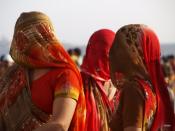Indian Women, Discrimination, and Their Struggle for Status Indian women, and women in general for that matter, have been no strangers to discrimination. Since the nineteenth century, Indian women who have married outside of their race have suffered from a form of discrimination, which was shared by neither male Indians nor other female Canadians. Until the introduction of Bill C-31 in 1985, Indian women automatically lost their status as an Indian when they chose to marry a non-Indian partner. This has had many negative repercussions, not only on the women themselves, but on their offsprings as well. Prior to the nineteenth century, women in many Indian societies, (the Iroquois of Ontario and Quebec for one), played a much more dominant role within their culture than they do even today. Women were considered equal among their people, with as much or more say than the men of their tribes in many matters.
It was the sociological ideals of the growing population of Eurocanadians that relegated women to an inferior role to men. As they expanded into more parts of Canada, their patriarchal ways were imposed on the resident Indian peoples and as a result, Indian women were left out of even the small role Indian men played in the shaping of the new nation. (Ponting, 1991) It was in 1869 that Indian women were officially relegated to a lesser role than their male counterparts. An amendment to the British North America Act of 1867 was passed which stated that an Indian woman that married outside of her race was no longer considered to be an Indian and, that any offspring from this union would also lose all claims to Indian status. The Act also stipulated that any Indian woman marrying an Indian man would only be a member of her husband's...


